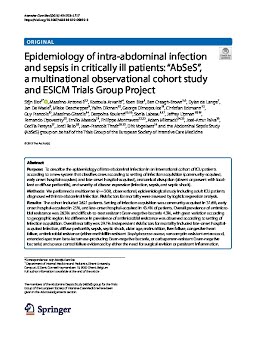2019-10-29
Epidemiology of intra-abdominal infection and sepsis in critically ill patients: "AbSeS", a multinational observational cohort study and ESICM Trials Group Project
Publication
Publication
Purpose: To describe the epidemiology of intra-abdominal infection in an international cohort of ICU patients according to a new system that classifes cases according to setting of infection acquisition (community-acquired, early onset hospital-acquired, and late-onset hospital-acquired), anatomical disruption (absent or present with local‑ ized or difuse peritonitis), and severity of disease expression (infection, sepsis, and septic shock). Methods: We performed a multicenter (n=309), observational, epidemiological study including adult ICU patients diagnosed with intra-abdominal infection. Risk factors for mortality were assessed by logistic regression analysis. Results: The cohort included 2621 patients. Setting of infection acquisition was community-acquired in 31.6%, early onset hospital-acquired in 25%, and late-onset hospital-acquired in 43.4% of patients. Overall prevalence of antimicro‑ bial resistance was 26.3% and difcult-to-treat resistant Gram-negative bacteria 4.3%, with great variation according to geographic region. No diference in prevalence of antimicrobial resistance was observed according to setting of infection acquisition. Overall mortality was 29.1%. Independent risk factors for mortality included late-onset hospitalacquired infection, difuse peritonitis, sepsis, septic shock, older age, malnutrition, liver failure, congestive heart failure, antimicrobial resistance (either methicillin-resistant Staphylococcus aureus, vancomycin-resistant enterococci, extended-spectrum beta-lactamase-producing Gram-negative bacteria, or carbapenem-resistant Gram-negative bacteria) and source control failure evidenced by either the need for surgical revision or persistent infammation. Conclusion: This multinational, heterogeneous cohort of ICU patients with intra-abdominal infection revealed that setting of infection acquisition, anatomical disruption, and severity of disease expression are disease-specifc pheno‑ typic characteristics associated with outcome, irrespective of the type of infection. Antimicrobial resistance is equally common in community-acquired as in hospital-acquired infection.
| Additional Metadata | |
|---|---|
| , , , , , | |
| doi.org/10.1007/s00134-019-05819-3, hdl.handle.net/1765/121504 | |
| Intensive Care Medicine | |
| Organisation | Department of Bioinformatics |
|
Blot, S., Antonelli, M., Arvaniti, K., Blot, K., Creagh-Brown, B., & de Lange, D. (2019). Epidemiology of intra-abdominal infection and sepsis in critically ill patients: "AbSeS", a multinational observational cohort study and ESICM Trials Group Project. Intensive Care Medicine. doi:10.1007/s00134-019-05819-3 |
|

